2011 PEUGEOT 5008 engine
[x] Cancel search: enginePage 101 of 340
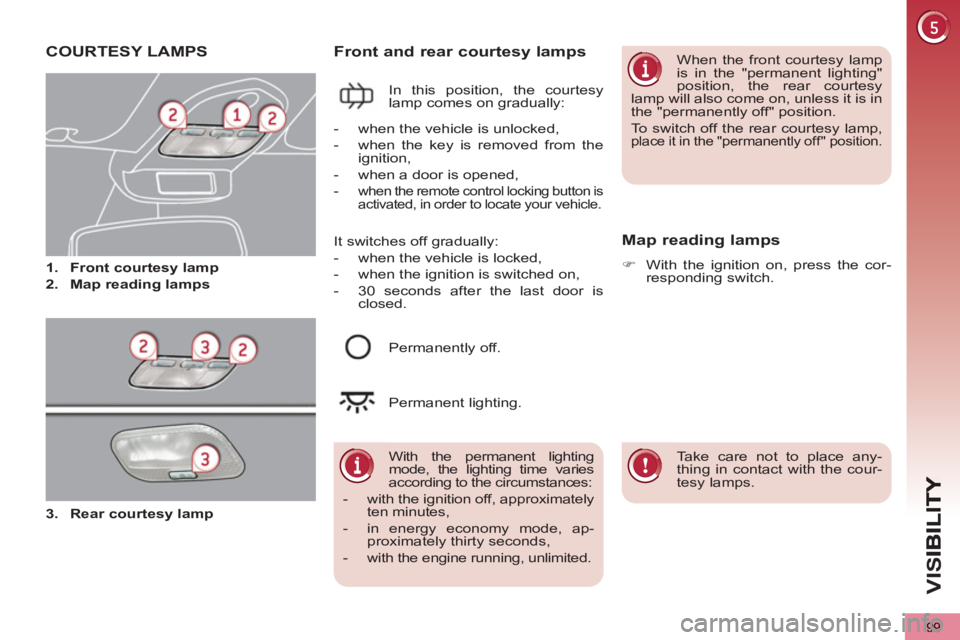
VIS
99
COURTESY LAMPS
1.
Front courtesy lamp
2.
Map reading lamps
Front and rear courtesy lamps
In this position, the courtesy
lamp comes on gradually:
Map reading lamps
�)
With the ignition on, press the cor-
responding switch.
With the permanent lighting
mode, the lighting time varies
according to the circumstances:
- with the ignition off, approximately
ten minutes,
- in energy economy mode, ap-
proximately thirty seconds,
- with the engine running, unlimited.
- when the vehicle is unlocked,
- when the key is removed from the
ignition,
- when a door is opened,
-
when the remote control locking button is
activated, in order to locate your vehicle.
Permanently off.
Permanent lighting. When the front courtesy lamp
is in the "permanent lighting"
position, the rear courtesy
lamp will also come on, unless it is in
the "permanently off" position.
To switch off the rear courtesy lamp,
place it in the "permanently off" position.
Take care not to place any-
thing in contact with the cour-
tesy lamps. It switches off gradually:
- when the vehicle is locked,
- when the ignition is switched on,
- 30 seconds after the last door is
closed.
3.
Rear courtesy lamp
Page 103 of 340
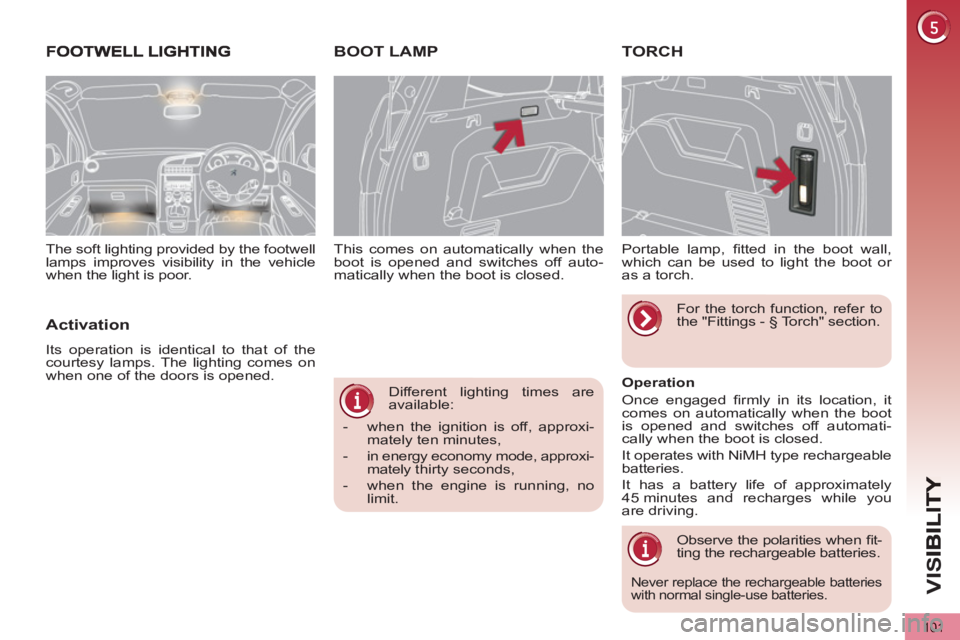
VIS
101
Different lighting times are
available:
- when the ignition is off, approxi-
mately ten minutes,
- in energy economy mode, approxi-
mately thirty seconds,
- when the engine is running, no
limit. This comes on automatically when the
boot is opened and switches off auto-
matically when the boot is closed.
BOOT LAMP TORCH
Portable lamp, fi tted in the boot wall,
which can be used to light the boot or
as a torch.
Operation
Once engaged fi rmly in its location, it
comes on automatically when the boot
is opened and switches off automati-
cally when the boot is closed.
It operates with NiMH type rechargeable
batteries.
It has a battery life of approximately
45 minutes and recharges while you
are driving.
Observe the polarities when fi t-
ting the rechargeable batteries.
Never replace the rechargeable batteries
with normal single-use batteries.
For the torch function, refer to
the "Fittings - § Torch" section.
Activation
Its operation is identical to that of the
courtesy lamps. The lighting comes on
when one of the doors is opened. The soft lighting provided by the footwell
lamps improves visibility in the vehicle
when the light is poor.
Page 109 of 340
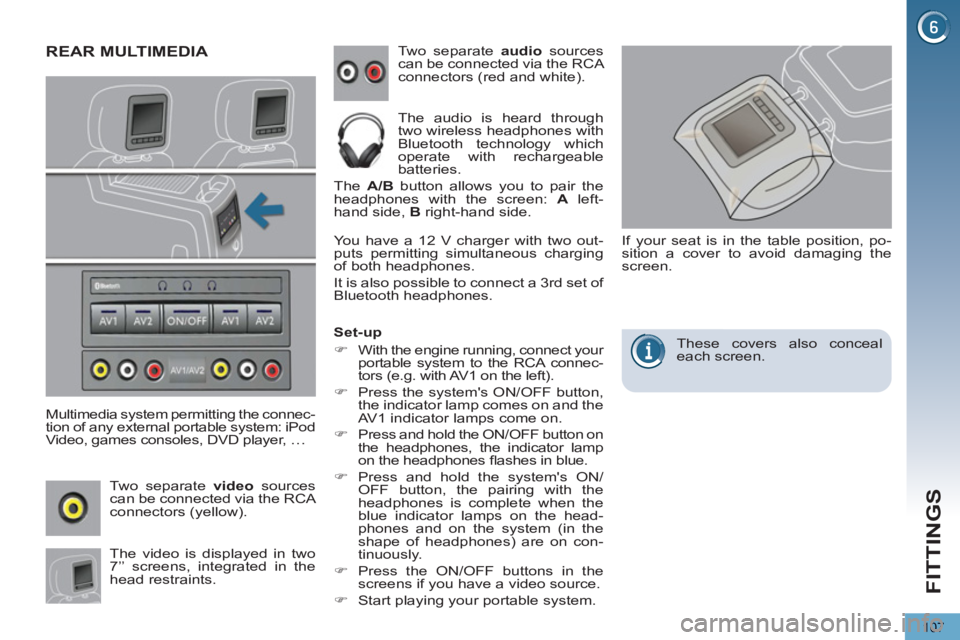
FITTINGS
107
REAR MULTIMEDIA
Multimedia system permitting the connec-
tion of any external portable system: iPod
Video, games consoles, DVD player, … Two separate audio
sources
can be connected via the RCA
connectors (red and white).
The audio is heard through
two wireless headphones with
Bluetooth technology which
operate with rechargeable
batteries.
The A/B
button allows you to pair the
headphones with the screen: A
left-
hand side, B
right-hand side.
The video is displayed in two
7’’ screens, integrated in the
head restraints. Two separate video
sources
can be connected via the RCA
connectors (yellow).
You have a 12 V charger with two out-
puts permitting simultaneous charging
of both headphones.
It is also possible to connect a 3rd set of
Bluetooth headphones.
Set-up
�)
With the engine running, connect your
portable system to the RCA connec-
tors (e.g. with AV1 on the left).
�)
Press the system's ON/OFF button,
the indicator lamp comes on and the
AV1 indicator lamps come on.
�)
Press and hold the ON/OFF button on
the headphones, the indicator lamp
on the headphones fl ashes in blue.
�)
Press and hold the system's ON/
OFF button, the pairing with the
headphones is complete when the
blue indicator lamps on the head-
phones and on the system (in the
shape of headphones) are on con-
tinuously.
�)
Press the ON/OFF buttons in the
screens if you have a video source.
�)
Start playing your portable system.
If your seat is in the table position, po-
sition a cover to avoid damaging the
screen.
These covers also conceal
each screen.
Page 132 of 340
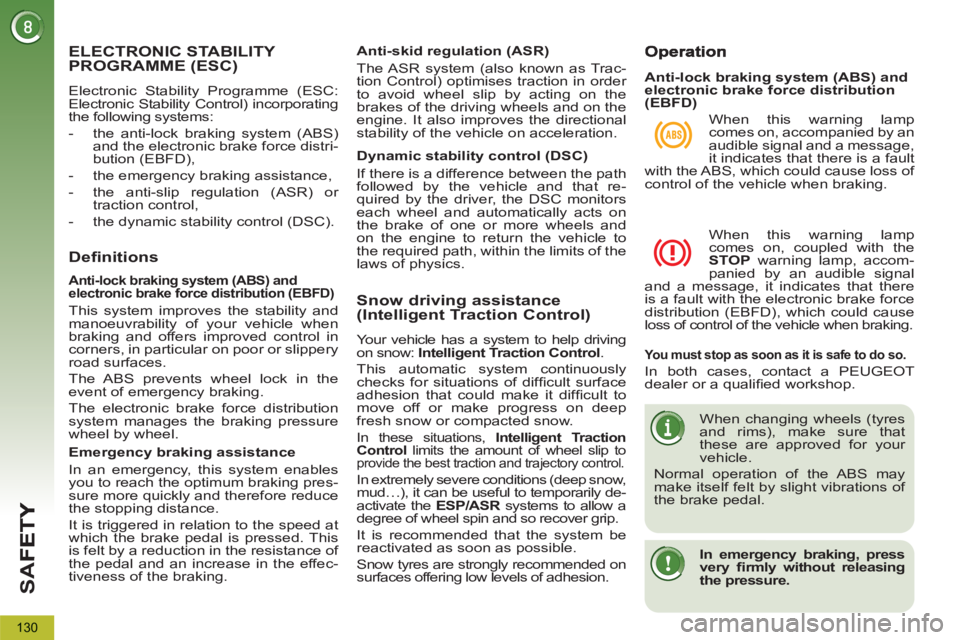
SA
F
130
ELECTRONIC STABILITY PROGRAMME (ESC)
Electronic Stability Programme (ESC:
Electronic Stability Control) incorporating
the following systems:
- the anti-lock braking system (ABS)
and the electronic brake force distri-
bution (EBFD),
- the emergency braking assistance,
- the anti-slip regulation (ASR) or
traction control,
- the dynamic stability control (DSC).
Definitions
Anti-skid regulation (ASR)
The ASR system (also known as Trac-
tion Control) optimises traction in order
to avoid wheel slip by acting on the
brakes of the driving wheels and on the
engine. It also improves the directional
stability of the vehicle on acceleration.
Dynamic stability control (DSC)
If there is a difference between the path
followed by the vehicle and that re-
quired by the driver, the DSC monitors
each wheel and automatically acts on
the brake of one or more wheels and
on the engine to return the vehicle to
the required path, within the limits of the
laws of physics.
Emergency braking assistance
In an emergency, this system enables
you to reach the optimum braking pres-
sure more quickly and therefore reduce
the stopping distance.
It is triggered in relation to the speed at
which the brake pedal is pressed. This
is felt by a reduction in the resistance of
the pedal and an increase in the effec-
tiveness of the braking.
Anti-lock braking system (ABS) and
electronic brake force distribution (EBFD)
This system improves the stability and
manoeuvrability of your vehicle when
braking and offers improved control in
corners, in particular on poor or slippery
road surfaces.
The ABS prevents wheel lock in the
event of emergency braking.
The electronic brake force distribution
system manages the braking pressure
wheel by wheel.
When this warning lamp
comes on, accompanied by an
audible signal and a message,
it indicates that there is a fault
with the ABS, which could cause loss of
control of the vehicle when braking.
When this warning lamp
comes on, coupled with the
STOP
warning lamp, accom-
panied by an audible signal
and a message, it indicates that there
is a fault with the electronic brake force
distribution (EBFD), which could cause
loss of control of the vehicle when braking.
You must stop as soon as it is safe to do so.
In both cases, contact a PEUGEOT
dealer or a qualifi ed workshop.
When changing wheels (tyres
and rims), make sure that
these are approved for your
vehicle.
Normal operation of the ABS may
make itself felt by slight vibrations of
the brake pedal.
In emergency braking, press
very fi rmly without releasing
the pressure.
Anti-lock braking system (ABS) and
electronic brake force distribution
(EBFD)
Snow driving assistance(Intelligent Traction Control)
Your vehicle has a system to help driving
on snow: Intelligent Traction Control.
This automatic system continuously
checks for situations of diffi cult surface
adhesion that could make it diffi cult to
move off or make progress on deep
fresh snow or compacted snow.
In these situations, Intelligent Traction
Control
limits the amount of wheel slip to
provide the best traction and trajectory control.
In extremely severe conditions (deep snow,
mud…), it can be useful to temporarily de-
activate the ESP/ASR
systems to allow a
degree of wheel spin and so recover grip.
It is recommended that the system be
reactivated as soon as possible.
Snow tyres are strongly recommended on
surfaces offering low levels of adhesion.
Page 133 of 340

SA
F
131
Dynamic stability control (DSC)
The DSC system offers excep-
tional safety in normal driving,
but this should not encourage the
driver to take extra risks or drive at high
speed.
The correct functioning of the system
depends on observation of the manu-
facturer's recommendations regarding
the wheels (tyres and rims), the braking
components, the electronic components
and the PEUGEOT assembly and op-
eration procedures.
After an impact, have the system
checked by a PEUGEOT dealer or a
qualifi ed workshop.
Deactivation
In exceptional conditions (starting a vehicle
which is bogged down, stuck in snow, on
soft ground...), it may be advisable to deac-
tivate the DSC system, so that the wheels
can move freely and regain grip.
�)
Press the "ESP OFF"
button.
This warning lamp and the indi-
cator lamp in the button come
on: the DSC system no longer
acts on the operation of the inter-
nal combustion engine.
Reactivation
The system is reactivated automatically
each time the ignition is switched back
on or from 30 mph (50 km/h).
Operating fault
If this warning lamp comes on,
accompanied by an audible sig-
nal and a message in the multi-
function screen, this indicates a
malfunction of the system.
Contact a PEUGEOT dealer or a quali-
fi ed workshop to have the system
checked.
This is indicated by fl ashing of this
warning lamp in the instrument
panel.
Activation
This system is activated automatically
each time the vehicle is started.
It comes into operation in the event of a
grip or trajectory problem.
�)
Press the "ESP OFF"
button again
to reactivate it manually.
Page 135 of 340
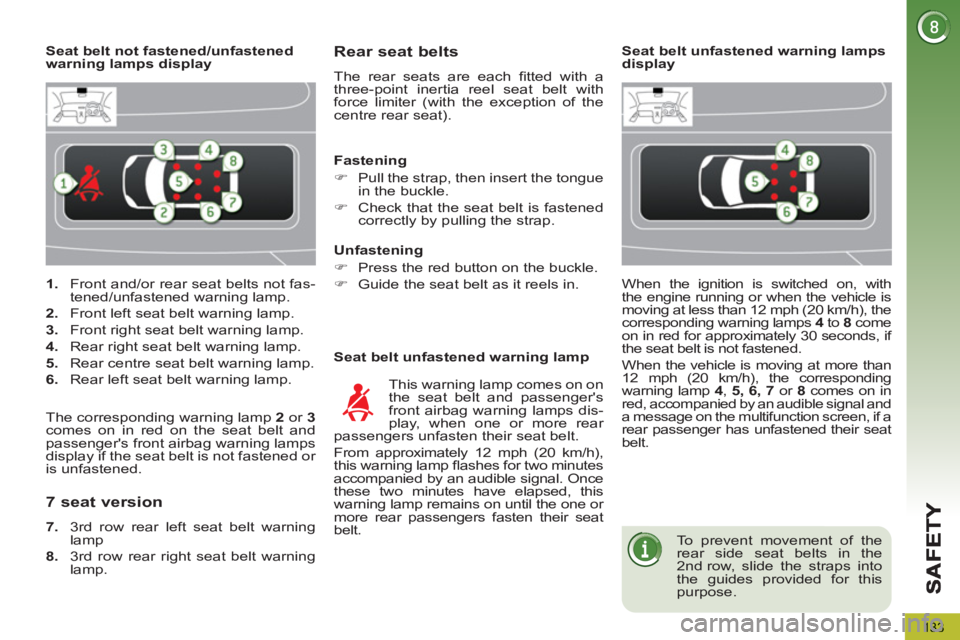
133
1.
Front and/or rear seat belts not fas-
tened/unfastened warning lamp.
2.
Front left seat belt warning lamp.
3.
Front right seat belt warning lamp.
4.
Rear right seat belt warning lamp.
5.
Rear centre seat belt warning lamp.
6.
Rear left seat belt warning lamp.
Seat belt not fastened/unfastened
warning lamps display
Rear seat belts
The rear seats are each fi tted with a
three-point inertia reel seat belt with
force limiter (with the exception of the
centre rear seat).
Seat belt unfastened warning lamp
This warning lamp comes on on
the seat belt and passenger's
front airbag warning lamps dis-
play, when one or more rear
passengers unfasten their seat belt.
From approximately 12 mph (20 km/h),
this warning lamp fl ashes for two minutes
accompanied by an audible signal. Once
these two minutes have elapsed, this
warning lamp remains on until the one or
more rear passengers fasten their seat
belt.
Fastening
�)
Pull the strap, then insert the tongue
in the buckle.
�)
Check that the seat belt is fastened
correctly by pulling the strap.
Unfastening
�)
Press the red button on the buckle.
�)
Guide the seat belt as it reels in.
The corresponding warning lamp 2
or 3
comes on in red on the seat belt and
passenger's front airbag warning lamps
display if the seat belt is not fastened or
is unfastened.
7 seat version
7.
3 rd
row rear left seat belt warning
lamp
8.
3
rd
row rear right seat belt warning
lamp.
Seat belt unfastened warning lamps
display
When the ignition is switched on, with
the engine running or when the vehicle is
moving at less than 12 mph (20 km/h), the
corresponding warning lamps 4
to 8
come
on in red for approximately 30 seconds, if
the seat belt is not fastened.
When the vehicle is moving at more than
12 mph (20 km/h), the corresponding
warning lamp 4
, 5, 6, 7
or 8
comes on in
red, accompanied by an audible signal and
a message on the multifunction screen, if a
rear passenger has unfastened their seat
belt.
To prevent movement of the
rear side seat belts in the
2 nd row, slide the straps into
the guides provided for this
purpose.
Page 142 of 340
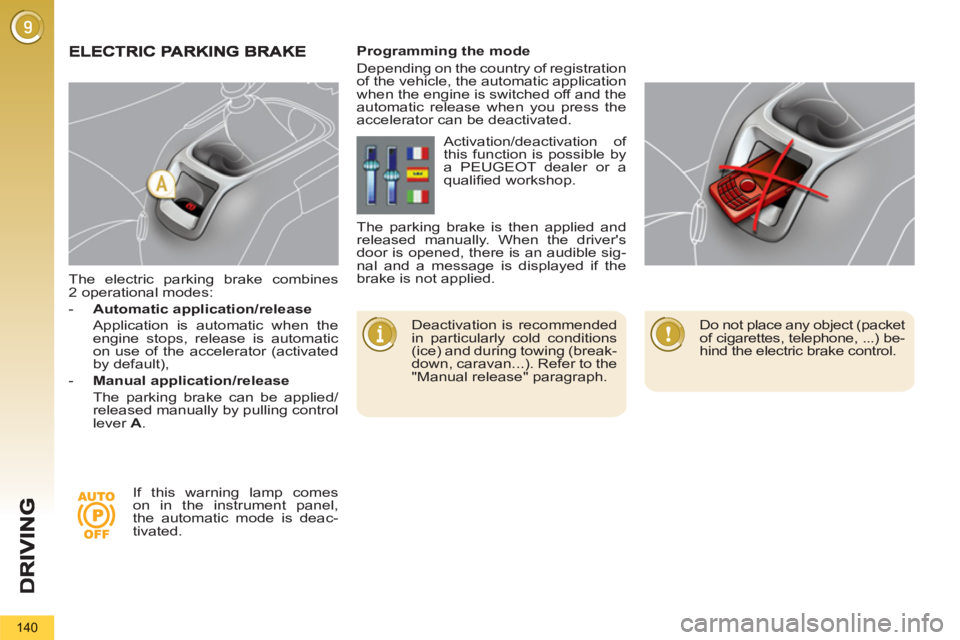
140
The electric parking brake combines
2 operational modes:
- Automatic application/release
Application is automatic when the
engine stops, release is automatic
on use of the accelerator (activated
by default),
- Manual application/release
The parking brake can be applied/
released manually by pulling control
lever A
.
Deactivation is recommended
in particularly cold conditions
(ice) and during towing (break-
down, caravan...). Refer to the
"Manual release" paragraph.
Programming the mode
Depending on the country of registration
of the vehicle, the automatic application
when the engine is switched off and the
automatic release when you press the
accelerator can be deactivated.
If this warning lamp comes
on in the instrument panel,
the automatic mode is deac-
tivated. Activation/deactivation of
this function is possible by
a PEUGEOT dealer or a
qualifi ed workshop.
The parking brake is then applied and
released manually. When the driver's
door is opened, there is an audible sig-
nal and a message is displayed if the
brake is not applied.
Do not place any object (packet
of cigarettes, telephone, ...) be-
hind the electric brake control.
Page 143 of 340
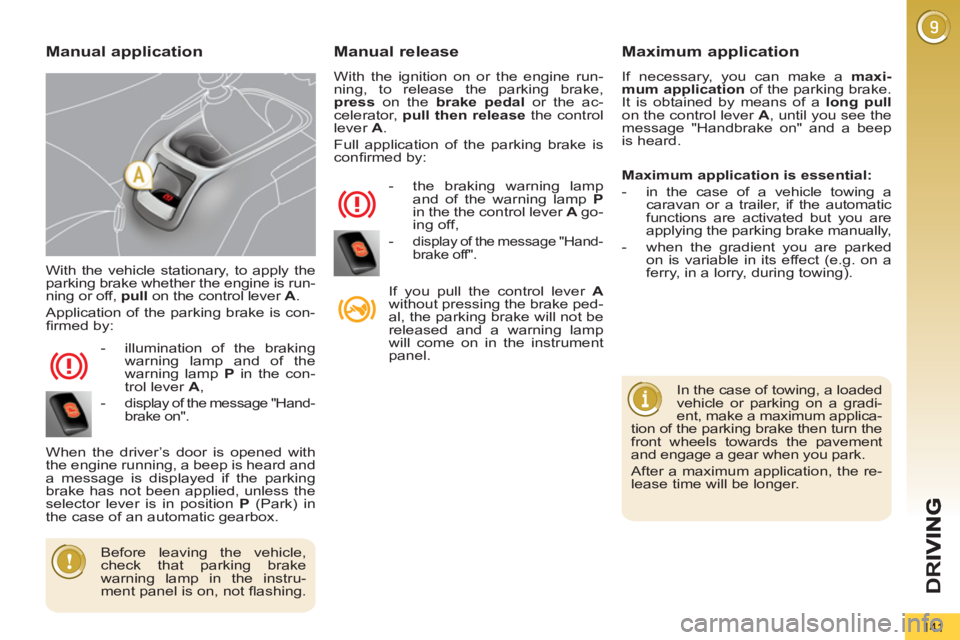
D
R
141
With the vehicle stationary, to apply the
parking brake whether the engine is run-
ning or off, pull
on the control lever A
.
Application of the parking brake is con-
fi rmed by:
- illumination of the braking
warning lamp and of the
warning lamp P
in the con-
trol lever A
,
-
display of the message "Hand-
brake on".
When the driver’s door is opened with
the engine running, a beep is heard and
a message is displayed if the parking
brake has not been applied, unless the
selector lever is in position P
(Park) in
the case of an automatic gearbox.
Manual release
With the ignition on or the engine run-
ning, to release the parking brake,
press
on the brake
pedal
or the ac-
celerator, pull then release
the control
lever A
.
Full application of the parking brake is
confi rmed by:
- the braking warning lamp
and of the warning lamp P
in the the control lever A
go-
ing off,
-
display of the message "Hand-
brake off".
If you pull the control lever A
without pressing the brake ped-
al, the parking brake will not be
released and a warning lamp
will come on in the instrument
panel.
Manual applicationMaximum application
If necessary, you can make a maxi-
mum application
of the parking brake.
It is obtained by means of a long pull
on the control lever A
, until you see the
message "Handbrake on" and a beep
is heard.
In the case of towing, a loaded
vehicle or parking on a gradi-
ent, make a maximum applica-
tion of the parking brake then turn the
front wheels towards the pavement
and engage a gear when you park.
After a maximum application, the re-
lease time will be longer.
Before leaving the vehicle,
check that parking brake
warning lamp in the instru-
ment panel is on, not fl ashing.
Maximum application is essential:
- in the case of a vehicle towing a
caravan or a trailer, if the automatic
functions are activated but you are
applying the parking brake manually,
- when the gradient you are parked
on is variable in its effect (e.g. on a
ferry, in a lorry, during towing).